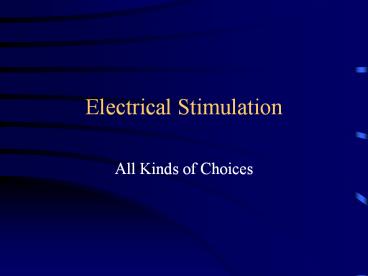Electrical Stimulation - PowerPoint PPT Presentation
1 / 33
Title:
Electrical Stimulation
Description:
Electrical Stimulation All Kinds of Choices Stimulating Units Fall into one of two categories: Low Volt (Less than 100V) TENS (9V battery) High Volt (Greater than ... – PowerPoint PPT presentation
Number of Views:332
Avg rating:3.0/5.0
Title: Electrical Stimulation
1
Electrical Stimulation
- All Kinds of Choices
2
Stimulating Units
- Fall into one of two categories
- Low Volt (Less than 100V)
- TENS (9V battery)
- High Volt (Greater than 100V)
- Pretty much everything else
3
Carrier Frequencies
- Low-frequency currents
- 1000 pps or less (Monophasic, Biphasic)
- Medium-frequency currents
- 1000 pps 100,000 pps (IFC, Russian)
- High-frequency currents
- 100,000 pps and higher (Diathermies)
4
Waveforms
- Monophasic
- Biphasic
- Interferential
- Pre-modulated Interferential
- Russian
- TENS
- Microcurrent
5
Monophasic
- Unidirectional flow of electrons
- Negative / Positive polarity
- Twin Peaked Monophasic
6
Peak Current
75 µs
Pulse Duration
7
Biphasic
- Positive and Negative Phases
- Symmetrical / Asymmetrical
8
(No Transcript)
9
Interferential Current
- Two channels at separate frequencies
- Less skin resistance
- Quadripolar Electrode Configuration
10
Interferential
Channel 1
5,000 Hz
Channel 2
5,100 Hz
11
Interference Current
Beat Frequency 100 Hz
12
Ch 2
Ch 1
Ch 1
Ch 2
13
Pre-modulated IFC
- Bipolar electrode configuration
- Mixing of currents occurs inside the machine
- Less penetration than IFC
14
Russian
- Classical Russian Stim involves 2500 Hz carrier
frequency w/ beat frequency from 1 100 Hz - Thought to allow more current to reach motor
nerve at lower intensities - Results have never been duplicated
15
TENS
- Transcutaneous Electrical Nerve Stimulation
- Primarily used for pain reduction
- Gate Control
- Endogenous-opiate release
16
Microcurrent
- Subsensory or very low sensory level
- Very small current amperage / Very high pulse
duration - Very theoretical / not much supporting research
- Attempts to re-establish bodys natural
electrical balance by allowing ATP supply to
increase ? metabolic energy for healing to occur
17
Levels of Electrical Stimulation
- Subsensory
- Sensory
- Pain Relief
- Edema Control
- Motor
- Pain Relief
- Edema Control
- Muscle Re-education
- Noxious
18
Subsensory
- Microcurrent
- Unable to stimulate nerve or muscle
- Variety of recommended parameters
- Generally consists of 2 10 minute Txs
19
Parameters
- 1st Treatment
- Frequency 30 Hz
- Intensity 600 µA
- 2nd Treatment
- Frequency .3 Hz
- Intensity 60 µA
- Lynn Wallace
- Pain Mode
- Frequency 30 Hz
- Intensity 80-100 µA
- Healing Mode
- Frequency .3 Hz
- Intensity 20-40 µA
20
Sensory Level Pain Relief
- Stimulation at or above sensory threshold but
below motor level - Stimulation of Aß fibers
- Gate Control Theory
21
- Frequency 50 150 Hz
- Phase Duration Less than 100 µs
- Intensity Comfortably strong
22
Sensory Level Edema Control
- Done immediately following injury to limit
formation of edema - Not widely researched but a few theories
- Decreased capillary pressure and permeability
which keeps plasma and proteins from entering
extracellular tissues - Vascular spasm preventing leaking from vessels
23
- Waveform Monophasic
- Frequency 120 pps
- Phase Duration As high as possible
- Intensity Comfortably strong
- Monopolar electrode configuration
- Negative electrodes over injured area
24
Motor Level Pain Control
- Best used with subacute / chronic pain
- Endogenous opiate release
- Longer duration of pain relief
- Also good for trigger points
25
- Frequency Low 2-4 pps
- Phase Duration Wide 200-300 µs
- Intensity Strong, twitch contractions
26
Motor Level Edema Control
- Muscular contractions encourage venous and
lymphatic milking fluids from the area - Electrodes arranged to follow primary vein
exiting swollen area - May be continuous or on / off time
27
- Continuous
- Frequency 1 2pps
- (or as low as possible)
- Phase Duration
- 200 400 µs
- Intensity
- Strong, twitch contractions
- On / Off time
- Frequency 25 50pps
- Phase Duration
- 200 400 µs
- Intensity
- Strong, tonic contractinons
- Duty Cycle 50
- 5 on / 5 off
- 10 on / 10 off
28
Muscle Re-education
- Neuromuscular Electrical Stimulation (NMES)
- Muscle re-education, reduction of spasticity,
delay of atrophy, muscle strengthening - Stronger type of current, not as comfortable as
other forms of ES - Not as effective as voluntary contractions
29
- Frequency 25 50 pps
- Phase Duration 200 400 µs
- Intensity Strong tonic contractions
30
NMES Principles
- Duty Cycle
- 15 (10 on / 50 off) ? Strength
- 12 (10 on / 20 off) ? Endurance
- 11 (10 on / 10 off) ? Fatigue
- Ramp Times
- Fast ramp on .5 1 sec ? Power
- Long ramp on 1 2 sec ? Strength
- Long ramp off 3 5 sec ? Eccentrics
31
Noxious Stimuli
- Causing pain to relieve pain
- Stimulation of Ad and C fibers
- Electrode placement is variable
- Generally used as a last resort
- Longer lasting pain relief
32
- Frequency 1-5 pps or 80-100 pps
- Phase Duration 1 ms or higher
- Intensity Noxious (painful)
33
Conclusion
- Lots of machines, lots of choices.
- Everybody is different, so dont be afraid to try
different things if things arent going as
planned.

